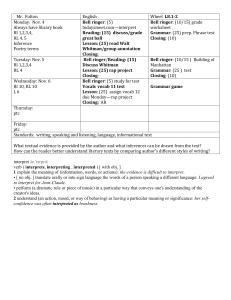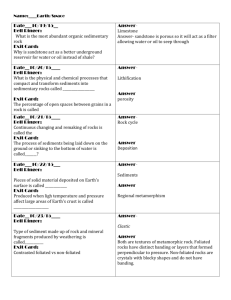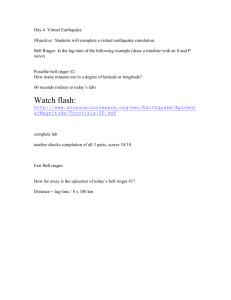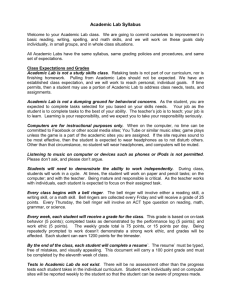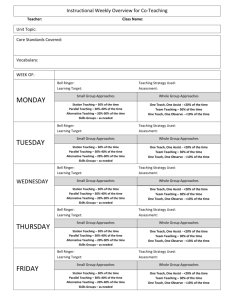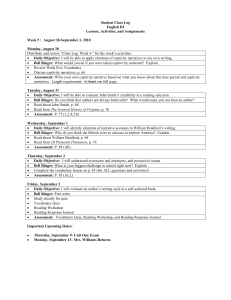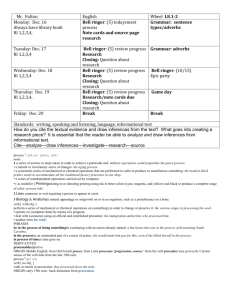Advanced Chemistry
advertisement
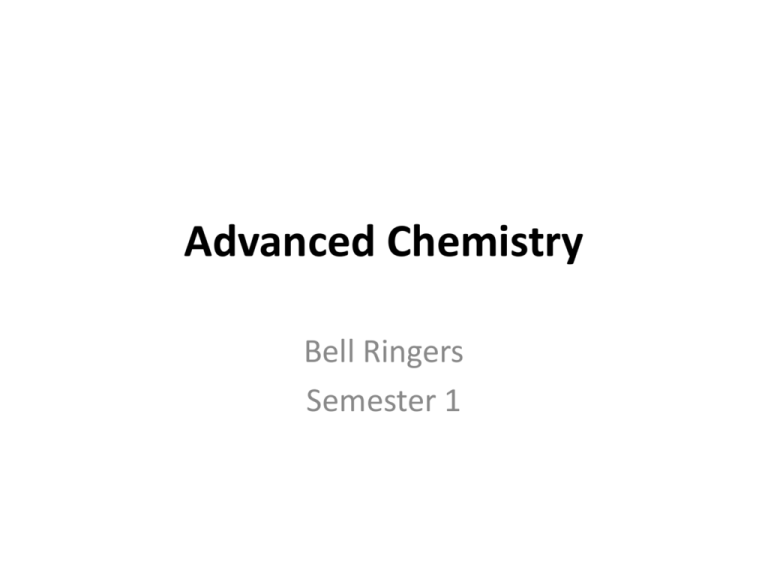
Advanced Chemistry Bell Ringers Semester 1 Bell Ringer 8/26/15 Welcome Back! Please take a moment to write down some materials you will need for this class: 2 composition book lined, 1 composition book graphing, calculator with scientific notation and ability to do log functions, pens for labs, pencils for homework, and $20 lab fee. Exit Closing 8/26/15 The melting point of pure benzoic acid is 122°C. Data obtained by four students in a laboratory experiment are shown. Which student’s data are precise but not accurate? Student A 115°C Student B 119°C Student C 122°C Student D 118°C 112°C 118°C 121°C 120°C 118°C 119°C 122°C 124°C 116°C 120°C 121°C 126°C A) Student A B) Student B C) Student C D) Student D Bell Ringer 8/27/15 3 Question Mini Pre-Quiz Which of these are chemical properties of matter? I) Corrosiveness II) Density III) Flammability IV) Melting point A) I and II B) I and III C) II and IV D) III and IV Which of these atomic and/or molecular views represent pure substances? I II III IV A) I and III B) II and IV C) I, II and IV D) II, III, and IV Extensive properties of a pure substance depend on sample size whereas intensive properties are characteristic of that substance. Which of these properties are intensive? I) Color II) Mass III) Density A) I and II B) I and III C) II and III D) I, II and III Exit Closing 8/27/15 What are the bubbles in the bottom of a boiling pot of water? Bell Ringer 8/28/15 What do the bubbles in the bottom of a boiling pot of water have to do with the ideal gas law? P1V1 = P2V2 T1 T2 Exit Closing 8/28/15 Turn to page 8 of your book and copy your own version of the flow chart into your composition book. Bell Ringer 8/31/15 Use the graduated cylinder and pipette to prove that you can put 8.5 ml of water in your cylinder. When you think your meniscus is in the correct position, call me over to initial a sketch of the cylinder that you have recorded in your book. Exit Closing 8/31/15 Write one sentence that explains what zeros and significant and which are not. Be prepared to share. Bell Ringer 9/1/15 In which of these measured values are the zeros not significant figures? I) 0.0591 cm II) 504 g III) 2.70 m IV) 5300 L A) I and II B) II and III D) I, III, and IV E) II, III, and IV C) I and IV Exit Closing 9/1/15 We will entertain 3 questions or comments before we leave today. You have one minute to write down one question that you should be prepared to share. Bell Ringer 9/2/15 Use the triple beam balance to measure your object. Sketch the slider bars into your notebook and record its mass. When you think you are accurate call me over for a signature. Exit Closing 9/2/15 What do graduated cylinder and triple beam measurements have to do with significant digits? Bell Ringer 9/3/15 The answer to the problem below is: 101 Explain how you reach this answers and the steps you would take to solve it. 67.304 + 5.0 x 6.14 + 3.1 = Exist Closing 9/3/15 Write one sentence to explain the rounding rule for if the digit you are cutting off is a 5. Example: Round 37.85 to three sig figs Or Example: Round 37.95 to three sig figs Bell Ringer 9/4/15 Determining the density of an egg is difficult. Propose how you would use water, salt, an egg and a container to calculate the density of an egg. Remember that D = Mass/Volume. Hint…Hint… Exit Closing 9/4/15 A metal sample is hammered into a rectangular sheet with an area of 31.2 ft2 and an average thickness of 2.30 × 10−6 cm. If the mass of this sample is 0.4767 g, predict the identity of the metal. The density of the metal is shown in parenthesis. Useful information: 1 in = 2.54 cm A) Aluminum (2.70 g/cm3) B) Copper (8.95 g/cm3) C) Gold (19.3 g/cm3) D) Zinc (7.15 g/cm3) Bell Ringer 9/8/15 Referring to 1.7 Write a brief explanation of the COAST framework for solving problems. Exit Closing 9/8/15 Convert 100 ml to liters using the COAST framework. Note that this is a simple problem to illustrate the structure. Bell Ringer 9/9/15 Record the formulas for converting Celsius to Fahrenheit, Fahrenheit to Celsius, Celsius to Kelvin and Kelvin to Celsius in your composition books. Exit Closing 9/9/15 Neon has a boiling point of 27 K. Express this temperature in degrees Fahrenheit. A) 352°F B) 168°F C) −246°F D) −411°F Bell Ringer 9/10/15 Apply the COAST framework to End of Chapter Question #86 and answer parts (a) and (b). We will discuss the answer at the end of the class. Mass (g) Height (cm) Diameter (cm) Cylinder A 15.560 5.1 1.2 Cylinder B 35.536 5.9 1.3 Exit Closing 9/10/15 Apply the COAST framework to End of Chapter Question #86 and answer parts (c) and (d). Be prepared to share 1 of the 4 parts with the class. Mass (g) Height (cm) Diameter (cm) Cylinder A 15.560 5.1 1.2 Cylinder B 35.536 5.9 1.3 Collect and Organize For this problem we try to identify which cylinder is made of aluminum and which is made of titanium by comparing experimentally determined densities with the known densities. volume of cylinder = height of cylinder ´ p ´ (radius) where radius = 0.5´ diameter. Analyze (a) To calculate the volume of each cylinder from its dimensions, we will have to use the equation for volume of a cylinder: (b) To calculate the volume from the water displacement method, we need only find the difference in water volume for each cylinder from the diagram in Figure P1.86. (c) To determine the method with the most significant figures, we will compare the answers in parts a and b. (d) To compute the density for each cylinder, we use the equation for density: 2 Bell Ringer 9/11/15 Apply the COAST framework to answer the following question. Deepwater Horizon Oil Spill According to the U.S. government, 4.9 billion barrels of crude oil flowed into the Gulf of Mexico following the explosion that destroyed the Deepwater Horizon drilling rig in April, 2010. Express this volume of crude oil in liters and in cubic kilometers. (1 barrel of oil = 42 gallons.) Collect and Organize We are asked in this problem to convert 4.9 billion barrels of crude oil to liters and cubic kilometers. Analyze This is a conversion problem for which we will need the following conversion factors: 1´10 9 barrels 42 gal 1´10 –3 m 3 1 km , , , and billion barrel oil L 1000 m Think about It The oil gushed in this spill for 87 days—that is 9.0 109 L/day. Exit Closing 9/11/15 We will entertain 3 questions or comments before we leave today. You have one minute to write down one question that you should be prepared to share. Bell Ringer 9/14/15 Quiz Day! You have 3 minutes to make sure your Composition Book has all the information you might need in it. It is fair game to use on your quiz! Exit Closing 9/14/15 If there was one question on the quiz you feel like you were the best at put a star on the board next to that question. If there was one question on the quiz that was your weakness or the weakness of your classmates, put a heart by it (no reason for the heart besides to see your heart drawing skills). Bell Ringer 9/15/15 You will be making a flip book with the next 5 sheets in your composition book for chapter 2 INSTEAD of Cornell Notes. Yes it is graded. Please turn your book sideways. You will need to cut the pages to look like the following: Cut SMALL amounts off the top 4 pages to make tabs. Cut too much & you won’t have writing room! I suggest starting cutting with page 4 & work upward. Historical View of Atoms, Ions & Molecules Cut the Black Lines through these 4 sheets. Exit Closing 9/15/15 Two of the following are a truth and the other is a falsehood. Evaluate each statement to determine which is which and be prepared to share with the class. 1) Robert Millikan determined the size and mass of the electron. 2) Robert Millikan’s oil drum experiment led to the plum pudding model. 3) JJ Thomson discovered the electron using a cathode ray. Bell Ringer 9/16/15 Had the plum-pudding model been valid, how would the results of the gold-foil experiment have differed from what Geiger and Marsden actually observed? Collect and Organize We are asked to consider what Rutherford’s gold-foil experiments would have shown if the plum-pudding model had been valid. Analyze The plum-pudding model of the atom viewed the electrons as small particles in a diffuse, positively charged “pudding.” Solve Had the plum-pudding model been valid, the particles would have encountered only a diffuse positive charge when entering the atom, and they would have been only slightly deflected from their straight-line path. Think about It Because the positive charge in the atom was viewed as diffuse, no particles would have bounced back toward their source in an experiment confirming the plum-pudding model. The key result of Rutherford’s experiment was that a few particles came directly back toward the source, indicating a highly dense nucleus of positive charge. Exit Closing 9/16/15 Nearly all stable nuclides have at least as many neutrons as protons in their nuclei. Which very common nuclide is an exception? Collect and Organize Given that most stable nuclides have at least equal numbers of neutrons in their nuclei as protons (and often more), we are to identify the element to which this rule is an exception. Analyze Neutrons help stabilize the nucleus by counteracting the repulsive forces between protons. Solve Hydrogen, with only one proton, does not need neutrons to be stable and so is the exception. Think about It Hydrogen, however, can have one (for deuterium) and even two (for tritium) neutrons in its nucleus. Bell Ringer 9/17/15 Describe two ways in which particles and β particles differ. Needs some hints? You will be provided some visuals after 2 minutes. You should note that there are many more than 2 differences! Collect and Organize We are to describe two differences between and particles. Analyze Both and particles are the result of nuclear processes, but they differ in their masses and charges. Solve Alpha particles are massive (about the mass of the helium nucleus), whereas particles are very light (about the mass of an electron). These particles also have opposite charges: particles have a 2+ charge, whereas particles have a 1– charge. Think about It Alpha particles are composed of two protons and two neutrons, and so when they are emitted from a nucleus the mass of the nuclide goes down by two mass units and its atomic number is reduced by 2. Beta emission changes a neutron into a proton in the nucleus, and therefore the atomic number increases, but the mass of the nuclide changes very little. Exit Closing 9/17/15 How many protons, neutrons, and electrons are there in the following atoms? (a) 11B; (b) 19F; (c) 131I; (d) 222Rn An isotope is given by the symbol ZAX, where X is the element symbol from the periodic table, Z is the atomic number (the number of protons in the nucleus), and A is the mass number (the number of protons and neutrons in the nucleus). Often, Z is omitted because the element symbol gives us the same information about the identity of the element. To determine the number of neutrons in the nucleus for each named isotope, we subtract Z (number of protons) from A (mass number). If the elements are neutral (no charge), the number of electrons equals the number of protons in the nucleus. Atom Mass Number Atomic Number Number of Neutrons = Number of = Number of Mass Number – Atomic Electrons = Number of Protons Number Protons 5 6 5 (a) 11B 11 (b) 19F 19 9 10 9 (c) 131I 131 53 78 53 (d) 222Rn 222 86 136 86 Bell Ringer 9/18/15 Fill in the missing information in the following table of monatomic ions. Symbol 37Cl– ? ? ? Number of Protons ? 11 ? 88 Number of Neutrons ? 12 46 ? Number of Electrons ? 10 36 86 Mass Number ? ? 81 226 How many molecules are there in 24 grams of FeF3? How many molecules are there in 9.34 grams of LiCl? How many grams do 4.3 x 1021 molecules of UF6 weigh? Exit Closing 9/18/15 Phosgene was used as a chemical weapon during World War I. Despite the name, phosgene molecules contain no atoms of phosphorus. Instead, they contain atoms of carbon and the group 16 element in the second row of the periodic table and the group 17 element in the third row. What are the identities and atomic numbers of the two elements? Collect and Organize Knowing that the chemical weapon phosgene contains a second-row element in group 16 and a third-row element in group 17 as well as carbon, we are to name those particular elements and give their atomic numbers. Analyze The second-row elements start with lithium and end at neon. The third-row elements start at sodium and end at argon. Solve The elements in phosgene besides carbon are oxygen (group 16), with atomic number 8, and chlorine (group 17), with atomic number 17. Think about It Phosgene is a small molecule (COCl2) that is highly toxic and causes suffocation when inhaled. Bell Ringer 9/21/15 Swimming Pool Chemistry Compounds containing chlorine have long been used to disinfect the water in swimming pools, but in recent years a compound of a less corrosive halogen has become a popular alternative disinfectant. What is the name of this fourth-row element? Collect and Organize We are asked to name the fourth-row halogen that can be used as an alternative to chlorine as a disinfectant. Analyze The fourth-row elements start at potassium and end at krypton. The halogens are the elements in group 17. Solve The fourth-row halogen element is bromine. Think about It Iodine, the fifth-row halogen, can also be used as a disinfectant or antiseptic. We pee in the pool, leave our band aids, don’t wipe well and blow boogers for chlorine to disinfect! Exit Closing 9/21/15 Explain how percent natural abundances are used to calculate average atomic masses. Collect and Organize In this question we relate the percentage of natural abundance to the average atomic mass of an element. Analyze The natural abundance of an isotope of an element indicates how common that isotope is in nature (on Earth). Solve Isotopic abundances are used to compute the weighted average atomic mass. The known isotopic abundances must be considered since the dominance of one isotope will contribute most to the average mass. Think about It The high abundance of one isotope over another indicates its higher nuclear stability. Bell Ringer 9/22/15 The vanadium in nature consists of two isotopes: 50V and 51V. Which one is the more abundant? Collect and Organize Given the mass numbers (50 and 51) for the two isotopes of vanadium, we are to determine which is most abundant. Analyze The atomic mass on the periodic table for vanadium is 50.942 amu. This value is closer to 51 than to 50. Solve 51V is the more abundant isotope. Think about It In Appendix 3 you can see that 51V is actually 99.750% abundant, so 50V is only 0.250% abundant. Exit Closing 9/22/15 Rank the following molecules based on decreasing molecular mass. (a) H2; (b) Br2; (c) NO2; (d) C2H2; (e) BF3 Collect and Organize For a list of five compounds, we are to determine their molecular masses and then rank them in order of decreasing mass. Analyze When we use the masses on the periodic table to calculate the molecular masses, we obtain the following: H2 = 2.016 amu Br2 = 159.81 amu NO2 = 46.01 amu C2H2 = 26.04 amu BF3 = 13.83 amu Solve In order of decreasing molecular mass: (b) Br2 < (c) NO2 < (d) C2H2 < (e) BF3 < (a) H2. Think about It In this problem fewer significant figures were necessary for the molecular masses because we were going to compare masses, and the masses were not likely to be too close together to warrant more than four significant digits. Bell Ringer 9/23/15 Day 1 of 3 Density of an Egg Lab Before you can begin collecting data…you must have your lab book entry preapproved. Must be completed through safety before you can begin. Intro (last sentence is prediction), Procedures, Safety, Data & Observations, Calculations & Results (excel graphs et), Discussion of Results, References in ACS and Additional Questions Bell Ringer 9/24/15 Day 2 of 3 Density of an Egg Lab Before you can begin collecting data…you must have your lab book entry preapproved. Must be completed through safety before you can begin. Intro (last sentence is prediction), Procedures, Safety, Data & Observations, Calculations & Results (excel graphs et), Discussion of Results, References in ACS and Additional Questions Bell Ringer 9/25/15 Day 3 of 3 Density of an Egg Lab Last Day in Class…Grading on Monday! Intro (last sentence is prediction), Procedures, Safety, Data & Observations, Calculations & Results (excel graphs et), Discussion of Results, References in ACS and Additional Questions 3rd Person Only! Individual work! Bell Ringer 9/28/15 In what way is the molar mass of an ionic compound the same as its formula mass, and in what ways are they different? Collect and Organize For an ionic compound, we are asked to distinguish between its molar mass and its formula mass. Analyze The molar mass is the mass of 1 mol of the particles that compose a substance, and the formula mass is the mass of one formula unit of an ionic compound. Solve Both terms give us the mass of 1 mol of a substance. The distinction lies in the fact that the formula mass is reserved for the mass of a mole of a substance that does not have a defined molecular structure, such as ionic compounds held together by the attraction of the negative anions for the positive cations. Think about It For a molecular compound, the formula mass is equal to the molecular mass. These terms are often used interchangeably. Exit Closing 9/28/15 The following quantities of trace gases were found in a 1.0 mL sample of air. Calculate the number of moles of each compound in the sample. a. 1.4 1013 molecules of H2 b. 1.5 1014 atoms of He c. 7.7 1012 molecules of N2O d. 3.0 1012 molecules of CO Collect and Organize In this exercise, we convert the number of molecules of each gas found in the sample to moles. Analyze To convert the number of molecules to moles, we divide by Avogadro’s number. Solve (a) 1.4 1013 molecules of H 2 6.022 10 23 molecules/mol 2.3 10 11 mol H 2 (b) 1.5 1014 atoms of He 10 2.5 10 mol He 6.022 1023 atoms/mol (c) 7.7 1012 molecules of N 2 O 1.3 1011 mol N 2 O 23 6.022 10 molecules/mol (d) 3.0 1012 molecules of CO 5.0 1012 mol CO 23 6.022 10 molecules/mol Think about It The trace gas that has the largest number of atoms or molecules present also has the largest number of moles present. In this sample of air, the amount of the trace gases decreases in the order He > H2 > N2O > CO. Bell Ringer 9/29/15 Today we will have a BR, a Middle Q, and Exit Closing… How many moles of iron and how many atoms of iron are there in 2.5 moles of each of the following? (a) wolframite, FeWO4; (b) pyrite, FeS2; (c) magnetite, Fe3O4; (d) hematite, Fe2O3 Collect and Organize In this exercise we convert from the moles of iron contained in a substance to the number of atoms present. Analyze For each substance we need to take into account the number of moles of iron atoms present in 1 mol of the substance. For 2.5 mol of substance, then, a substance that contains two atoms of iron in its formula contains 2.5 2 = 5.0 mol of iron. We can then use Avogadro’s number to convert the moles of iron to the number of atoms present in the sample. Solve (a) Wolframite, FeWO4, contains one atom of Fe per formula unit, so 2.5 mol of wolframite contains 2.5 mol of Fe. (b) The formula for pyrite, FeS2, contains only one iron atom per formula unit as well, so the answer is identical to that calculated in part a. (c) Magnetite, Fe3O4, contains three iron atoms in its formula, so 2.5 mol of Fe3O4 contains 2.5 3 = 7.5 mol of iron. (d) Hematite, Fe2O3, contains two iron atoms in its formula, so 2.5 mol of hematite contains 2.5 2 = 5.0 mol of iron. Think about It The ratio of iron atoms in wolframite to pyrite to magnetite to hematite of 1: 1: 3: 2 reflects the number of iron atoms in their formulas. The Middle! 9/29/15 Which substance in each of the following pairs of quantities contains more moles of oxygen? a. 2 mol N2O or 1 mol N2O5 b. 1 mol NO or 1 mol Ca(NO3)2 c. 2 mol NO2 or 1 mol NaNO2 Collect and Organize Given the formulas and the moles of each substance in a pair, we are asked to decide which compound contains more moles of oxygen. Analyze To answer this question, we have to take into account the moles of oxygen present in the substance formulas as well as the initial number of moles specified for each substance. Solve (a) Two moles of N2O contains 2 mol of oxygen, and 1 mol of N2O5 contains 5 mol of oxygen. Therefore, N2O5 contains the most moles of oxygen. (b) One mole of NO contains 1 mol of oxygen, and 1 mol of calcium nitrate [Ca(NO3)2] contains 6 mol of oxygen. Therefore, the calcium nitrate contains six times more moles of oxygen than the NO. (c) Two moles of NO2 contains 4 mol of oxygen, and 1 mol of sodium nitrite (NaNO2) contains 2 mol of oxygen. The NO2 contains more moles of oxygen. Think about It We cannot decide which substance has more moles of oxygen by comparing only the amounts of substances present. If that were the case, we would have concluded wrongly that 2 mol of N2O contains more moles of oxygen than 1 mol of N2O5. Exit Closing 9/29/15 What nuclide is produced in the core of a collapsing giant star by each of the following reactions? 65 Cu + 3 1 n → ? + 0β a. 29 0 –1 b. 6830Zn + 2 10n → ? + –10β 88 Sr + 1 n → ? + 0β c. 38 0 –1 Collect and Organize We are asked to predict the products of neutron capture reactions in the core of a collapsing giant star. Analyze To solve this problem, we balance the reactions for mass number and atomic number between the reactants and products. We have to take into account that multiple neutrons can be added under these conditions. Solve (a) 65 Cu + 31 n ® 29 0 68 30 70 31 (b) 68 30 Zn + 2 10 n ® (c) 88 38 Sr + 10 n ® Zn + -10b Ga + -10b 89 39 Y + -10b Think about It Adding neutrons to the nucleus does not itself change the atomic number. Subsequent emission, however, does, and the result is the building up of heavier elements in the periodic table. Bell Ringer 9-30-15 Due to Homecoming Mayhem…You will need to either be working on your 6 essay quiz questions or as a group you can review for your first exam. Bell Ringer 10-1-15 Due to Homecoming Mayhem…You will need to either be working on your 6 essay quiz questions or as a group you can review for your first exam. Bell Ringer 10-5-15 Please have your 6 essay quiz questions stapled with the cover sheet. Be prepared to write a question selected by the roll of our dice. You may have out your learning log but not your book. Good Luck! Bell Ringer 10/6/15 Chapters 1 & 2 Exam Pick up your remote from the CPS bag. Be sure that it is YOUR number. Begin testing immediately. You may use: Scratch paper and a NONProgrammable Calculator. No Cell Phones! Bell Ringer 10/07/15 Pick up the Anticipatory Guide (T/F Sheet) on the side wall. Note that you are ONLY filling out the T/F column one. Before we begin this chapter we want a measure of what you know. You are NOT graded on this column. It is only to measure growth. AFTER the chapter, we will finish this sheet. Please do not work ahead. You have 5 minutes to go with your gut and guess True or False. Do not look up answers. Exit Closing 10-07-15 Submarine Communications The Russian and American navies developed extremely low-frequency communications networks to send messages to submerged submarines. The frequency of the carrier wave of the Russian network was 82 Hz, while the Americans used 76 Hz. What was the ratio of the wavelengths of the Russian network to the American network? To calculate the actual underwater wavelength of the transmissions in either network, what additional information would you need? Bell Ringer 10-08-15 Which radiation has the longer wavelength, (a) radio waves from an AM radio station broadcasting at 680 kHz or (b) infrared radiation emitted by the surface of Earth (l = 15 µm)? Exit 10-08-15 When dentists take X-rays, the patient is given a protective shield from excess radiation. How much more energy is there per photon from an X-ray (l = 71.2 pm) than from UV radiation (l = 250 nm)? Bell Ringer 10-9-15 Which of the following have quantized values? Explain your selections. a. The pitch of a note played on a slide trombone b. The pitch of a note played on a flute c. The wavelengths of light produced by the heating elements in a toaster d. The wind speed at the top of Mt. Everest Bell Ringer 10/9/15 Day 1 of 4 Chromatography Lab Before you can begin collecting data…you must have your lab book entry preapproved. Must be completed through safety before you can begin. Intro (last sentence is prediction), Procedures, Safety, Data & Observations, Calculations & Results (excel graphs et), Discussion of Results, References in ACS and Additional Questions Exit Closing 10-9-15 Titanium (F = 6.94 × 10–19 J) and silicon (F = 7.24 × 10–19 J) surfaces are irradiated with UV radiation with a wavelength of 250 nm. Which surface emits electrons with the longer wavelength? What is the wavelength of the electrons emitted by the titanium surface? Bell Ringer 10-12-15 Explain the difference between a ground-state H atom and an excited-state H atom. Exit Closing 10-12-15 Does the electromagnetic energy emitted by an excited-state H atom depend on the individual values of n1 and n2, or only on the difference between them (n1 – n2)? Bell Ringer 10-13-15 Without calculating any frequency values, rank the following transitions in the hydrogen atom in order of increasing frequency of the electromagnetic radiation that could produce them. a. n=4→n=6 b. n=6→n=8 c. n = 9 → n = 11 d. n = 11 → n = 13 Exit Closing 10-13-15 Why do matter waves not add significantly to the challenge of hitting a baseball thrown at 99 mph (44 m/s)? Bell Ringer 10-14-15 Which (if any) of the following statements about the frequency of a particle is true? a. Heavy, fast-moving objects have lower frequencies than those of lighter, faster-moving objects. b. Only very light particles can have high frequencies. c. Doubling the mass of an object and halving its speed result in no change in its frequency. Exit Closing 10-14-15 How rapidly would each of the following particles be moving if they all had the same wavelength as a photon of red light (l = 750 nm)? a. An electron of mass 9.10938 × 10–28 g b. A proton of mass 1.67262 × 10–24 g c. A neutron of mass 1.67493 × 10–24 g d. An α particle of mass 6.64 × 10–24 g Bell Ringer 10-19-15 How many orbitals are there in an atom with the following combinations of quantum numbers? a. n = 3, ℓ = 2 b. n = 3, ℓ = 1 c. n = 4, ℓ = 2, mℓ = 2 Exit Closing 10-19-15 Which are the possible values of mℓ when ℓ = 2? Bell Ringer 10-20-15 How many electrons could occupy orbitals with the following quantum numbers? a. n = 3, ℓ = 2 b. n = 5, ℓ = 4 c. n = 3, ℓ = 0 d. n = 4, ℓ = 1, mℓ = 1 Exit Closing 10-20-15 Why do so many transition metals form ions with a 2+ charge? Bell Ringer 10-21-15 Identify the subshells with the following combinations of quantum numbers and arrange them in order of increasing energy in an atom of gold: a. n = 2, ℓ = 1 b. n = 5, ℓ = 0 c. n = 3, ℓ = 2 d. n = 4, ℓ = 3 Exit Closing 10-21-15 In what way are the electron configurations of C, Si, and Ge similar? Bell Ringer 10-22-15 How many unpaired electrons are there in the following ground-state atoms and ions? (a) Sc; (b) Ag+; (c) Cd2+; (d) Zr4+ Exit Closing 10-22-15 Identify the element whose condensed electron configuration is [Ne]3s23p3. How many unpaired electrons are there in the ground state of this atom? Bell Ringer 10-23-15 Why does atomic size tend to decrease with increasing atomic number across a row of the periodic table? Exit Closing 10-23-15 Which of the group 17 elements forms the largest monatomic ions? Explain your selection. Bell Ringer 10-26-15 Finish the fill pattern for electrons below. 1s 2s 2p 3s 3p 3d 4s… Exit Closing 10-26-15 How many unpaired electrons are there in the iron (Z=26) atom? A) 0 B) 2 C) 4 D) 6 Bell Ringer 10-27-15 Select the electron configuration of 26Fe3+, the ferric ion. A) [Ar]3d64s2 B) [Ar]3d34s2 C) [Ar]3d6 D) [Ar]3d5 Exit Closing 10-27-15 Select the sequence of atoms that are correctly listed in order of increasing size. A) F < Br < Ge < K B) Na < Al < P < S C) Ba < Ca < Mg < Be D) Cl < Si < C < B Bell Ringer 10-28-15 Describe the differences in bonding in covalent and ionic compounds. Exit Closing 10-28-15 What is the electrostatic potential energy between a pair of aluminum and oxide ions in solid Al2O3? Bell Ringer 10-29-15 Rank the following ionic compounds, which have the same crystal structure, from least negative to most negative lattice energy: CsCl, CsBr, and CsI. Exit Closing 10-29-15 More than a dozen compounds containing sulfur and oxygen have been identified. What are the chemical formulas of the following six? (a) sulfur monoxide; (b) sulfur dioxide; (c) sulfur trioxide; (d) disulfur monoxide; (e) hexasulfur monoxide; (f) heptasulfur dioxide Bell Ringer 10-30-15 What are the names of these compounds? (a) RuS (b) PdCl2 (c) Ag2O (d) WO3 (e) PtO2 Exit Closing 10-30-15 Draw Lewis structures of the most stable ions formed by lithium, magnesium, aluminum, and fluorine. Bell Ringer 11-2-15 How many valence electrons are in each of these atoms or ions? Xe, Sr2+, Cl, and Cl– Exit Closing 11-2-15 Draw Lewis structures for the following molecular compounds and ions: (a) AlCl3, (b) PH3; (c) H2Se; (d) NO2–; (e) AlH4–. Bell Ringer 11-3-15 How do the electronegativities of the elements change across a row and down a group in the periodic table? Exit Closing 11-3-15 Which is the least polar bond? C—Se C==O Cl—Br O==O N—H C—H Bell Ringer 11-4-15 What factors determine whether or not a molecule or ion exhibits resonance? Exit Closing 11-4-15 Oxygen and sulfur combine to form a variety of different sulfur oxides. Some are stable molecules and some, including S2O2 and S2O3, decompose when they are heated. Draw Lewis structures for the two compounds showing all resonance forms. Bell Ringer 11-5-15 How do the electronegativities of elements influence the selection of which Lewis structure is favored? Exit Closing 11-5-15 Origins of Life The discovery of polyatomic organic molecules such as cyanamide (H2NCN) in interstellar space has led some scientists to believe that the molecules from which life began on Earth may have come from space. Draw Lewis structures for cyanamide, and select the preferred structure on the basis of formal charges. Bell Ringer 11-6-15 In which of the following molecules does the phosphorus atom have an expanded valence shell? (a) POCl3; (b) PF5; (c) PF3; (d) P2F4 (which has a P P bond) Exit Closing 11-6-15 Which of the following nitrogen oxides are oddelectron molecules? (a) NO; (b) NO2; (c) NO3; (d) N2O4; (e) N2O5 Bell Ringer 11-9-15 Rank the following ions in order of increasing carbon–oxygen bond lengths: CO, CO2, and CO32–. Exit Closing 11-9-15 Rank the following ions in order of increasing carbon–oxygen bond energy: CO, CO2, and CO32–. Bell Ringer 11/10/15 Chapters 3 & 4 Exam Pick up your remote from the CPS bag. Be sure that it is YOUR number. Begin testing immediately. You may use: Scratch paper and a NONProgrammable Calculator. No Cell Phones! Exit Closing 11/10/15 We will entertain 3 questions or comments before we leave today. You have one minute to write down one question that you should be prepared to share. Bell Ringer 11/11/15 Day 1 of 4 Foundry Lab (In the Library Days 1 & 4) Your lab notebook should focus on Short Intro with prediction, procedures, Safety, and Data Formal Write Up Should Include: Intro (last sentence is prediction), Procedures, Safety, Data & Observations, Calculations & Results (excel graphs et), Discussion of Results, References in ACS and Additional Questions Exit Closing 11/11/15 We will entertain 3 questions or comments before we leave today. You have one minute to write down one question that you should be prepared to share. Bell Ringer 11/12/15 Day 2 of 4 Foundry Lab Data Collection Day! Your lab notebook should focus on Short Intro with prediction, procedures, Safety, and Data Formal Write Up Should Include: Intro (last sentence is prediction), Procedures, Safety, Data & Observations, Calculations & Results (excel graphs et), Discussion of Results, References in ACS and Additional Questions Exit Closing 11/12/15 We will entertain 3 questions or comments before we leave today. You have one minute to write down one question that you should be prepared to share. Bell Ringer 11/13/15 Day 3 of 4 Foundry Lab Data Collection Day! Your lab notebook should focus on Short Intro with prediction, procedures, Safety, and Data Formal Write Up Should Include: Intro (last sentence is prediction), Procedures, Safety, Data & Observations, Calculations & Results (excel graphs et), Discussion of Results, References in ACS and Additional Questions Exit Closing 11/13/15 We will entertain 3 questions or comments before we leave today. You have one minute to write down one question that you should be prepared to share. Bell Ringer 11/16/15 Day 4 of 4 Foundry Lab (In the Library Days 1 & 4) Your lab notebook should focus on Short Intro with prediction, procedures, Safety, and Data Formal Write Up Should Include: Intro (last sentence is prediction), Procedures, Safety, Data & Observations, Calculations & Results (excel graphs et), Discussion of Results, References in ACS and Additional Questions Exit Closing 11/16/15 We will entertain 3 questions or comments before we leave today. You have one minute to write down one question that you should be prepared to share. Bell Ringer 11/17/15 In which molecular geometry do equatorial bonding pairs of electrons repel each other more: square pyramidal or trigonal bipyramidal? Exit Closing 11/17/15 The O–N–O bond angle in NO2 is slightly larger than it is in NO2–. Why? Bell Ringer 11/18/15 Rank the following molecules in order of increasing bond angles: (a) NH3; (b) CH4; (c) H2O. Exit Closing 11/18/15 Determine the molecular geometries of the following molecules and ions: (a) NO3–; (b) NO43–; (c) NCN2–; (d) NF3. Bell Ringer 11/19/15 Determine the molecular geometries of the following ions: (a) SCN–; (b) CH3PCl3+ (P is the central atom and is bonded to the C atom of the methyl group); (c) ICl2–; (d) PO33–. Exit Closing 11/19/15 Which two of the species N3–, O3, and CO2 have the same molecular geometry? Bell Ringer 11/20/15 Must a polar molecule contain polar covalent bonds? Why? Exit Closing 11/20/15 Which of the following molecules has a permanent dipole? (a) C4F8 (cyclic structure); (b) ClFCCF2; (c) Cl2HCCClF2 Bell Ringer 11/23/15 Which molecule in each of the following pairs is more polar? (a) NH3 or PH3; (b) CCl2F2 or CBr2F2 Exit Closing 11/23/15 What is the hybridization of nitrogen in each of the following ions and molecules? (a) NO2+; (b) NO2–; (c) N2O; (d) N2O5; (e) N2O3 Bell Ringer 11/24/15 How does the hybridization of the sulfur atom change in the series SF2, SF4, SF6? Exit Closing 11/24/15 What is the molecular geometry around sulfur and nitrogen in the sulfamate anion shown in Figure P5.73? Which atomic or hybrid orbitals overlap to form the S–O and S–N bonds in the sulfamate anion? Bell Ringer 11/30/15 Which of the molecules in Figure P5.82 are chiral? Exit Closing 11/30/15 Which of the molecules in Figure P5.84 are chiral? Bell Ringer 12/1/15 Do all σ molecular orbitals result from the overlap of s atomic orbitals? Exit Closing 12/1/15 Do all π molecular orbitals result from the overlap of p atomic orbitals? Bell Ringer 12/2/15 Diatomic noble gas molecules, such as He2 and Ne2, do not exist. Would removing an electron create molecular ions, such as He2+ and Ne2+, that are more stable than He2 and Ne2? Exit Closing 12/2/15 Which of the following molecular ions are diamagnetic? (a) O2–; (b) O22–; (c) N22–; (d) F2+ Bell Ringer 12/3/15 Which of the following molecular cations have electrons in π antibonding orbitals? (a) N2+; (b) O2+; (c) C22+; (d) Br22+ Exit Closing 12/3/15 For which of the following diatomic molecules does the bond order increase with the loss of two electrons, forming the corresponding 2+ cation? (a) B2; (b) C2; (c) N2; (d) O2 Bell Ringer 12/4/15 Cl2O2 may play a role in ozone depletion in the stratosphere. Draw the Lewis structure for Cl2O2 based on the skeletal structure in Figure P5.110. What is the geometry about the central chlorine atom? FIGURE P5 .110 Exit Closing 12/4/15 Ozone Depletion In 1999, the ClO+ ion, a potential contributor to stratospheric ozone depletion, was isolated in the laboratory. a. Draw the Lewis structure for ClO+. b. Using the molecular orbital diagram for ClO+ in Figure P5.113, determine the order of the Cl–O bond in ClO+. Bell Ringer 12/7/15 Early Earth Some scientists believe that an anion with the skeletal structure shown in Figure P5.114 may have played a role in the formation of nucleic acids before life existed on Earth. a. Complete the Lewis structure of this anion. b. Predict the C—P—O bond angle in the anion. Exit Closing 12/7/15 Two compounds formed by the reaction of boron with carbon monoxide have these skeletal structures: B–B–C–O and O–C–B–B–C–O. a. Draw the Lewis structures of both compounds that minimize formal charges. b. What are the B–B–C bond angles in the molecules?
